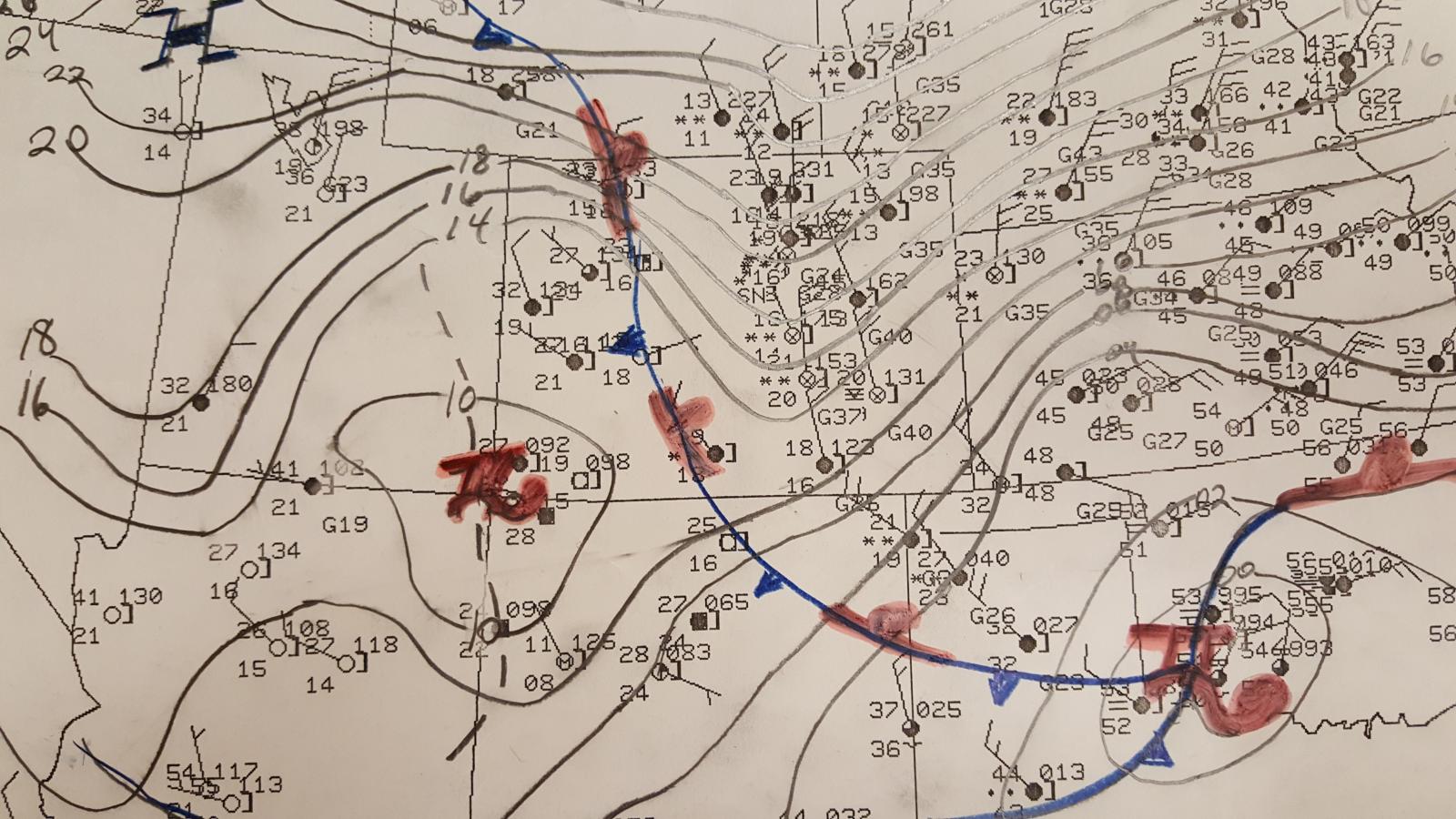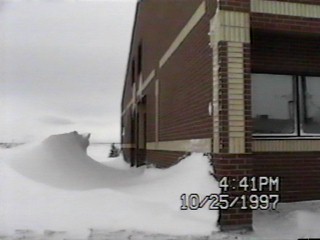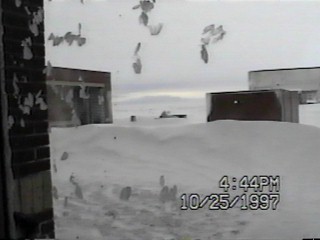
A winter-like pattern will continue over much of the Lower 48 over the next few days, with snow stretching from the Rockies today into the Middle Mississippi Valley on Monday. Showers and thunderstorms will develop along the Gulf Coast and Southeast on Monday. As the storm moves northward late Monday into Tuesday, winter weather is possible from the Central Appalachians to Interior New England. Read More >
The Blizzard of 1997 - October 24th - 26th
Considering the current weather pattern, it may be difficult to believe that 21 years ago a life-taking blizzard was raging across eastern Colorado. October blizzards are rare indeed, and the severity of that blizzard any time of year even rarer.
Below is a hand drawn surface map of the blizzard when it was strengthening Saturday morning the 25th. Close together lines of equal pressure produced blizzard winds (sustained and frequent gusts well above 35 mph), as air temperatures plummeted to the mid- to upper teens.

Blizzard conditions lasted in Colorado Springs from 9 p.m. Friday evening through 6 p.m. Saturday.

Shortly before 2 p.m. Saturday, at the Colorado Springs Airport, north winds gusted to 48 kts (55 mph) with an air temperature of 21 degrees. Nineteen inches of snow was measured at that time.
The scope and length of blizzard conditions proved fatal for several eastern Coloradans. Three people in El Paso county perished from carbon monoxide poisoning after waiting for help to come in their snowbound vehicles for over 24 hours. Another person froze to death in a vehicle on post at Fort Carson in the Colorado Springs area. An elderly women in Otero County tried to walk home after her vehicle became stuck in open country. She froze to death. A man in Bent county froze to death in open country while hunting, or looking for other hunters. Another man died in a vehicle accident in Pueblo during the blizzard Friday night.
(photo taken at NWS Pueblo)
Many people were injured during the blizzard. Two people were injured in Colorado Springs when a canopy at a gas station collapsed under the weight of deep snow on top. Another canopy at a gas station in Lamar collapsed, but no one was injured. A vehicle was destroyed, though.
Thousands of people were stranded in eastern Colorado, and hundreds had to be rescued from their snowbound vehicles.
By Saturday, the Governor declared a State of Emergency. Emergency traffic only was allowed on eastern Colorado roadways. Rescues were made by the U.S. Army in Humvees and by helicopter, the National Guard, law enforcement, other public resources, and private citizens. The combination of high wind and heavy snow caused power lines to come down. Power outages occurred (and lasted up to two days) in many parts of the area, most notably in parts of Colorado Springs, in and around Pueblo, and in southeast Colorado from McClave in Bent County to Holly in Prowers County. Hundreds of businesses and stores were closed throughout much of the weekend, and temporary sales and production loses were in the millions of dollars.
(photo taken at NWS Pueblo)
Many school districts were closed for a part, or all of the following week, as the digging out process continued.
Extra costs for snow removal in both the private and public sector from overtime wages certainly ran into the millions of dollars areawide. Not only did humans suffer, but there was a widespread die off of range cattle. Estimates of around 20,000 dead cattle and calves were given. Untold numbers were saved by hay drops carried out by the Army and National Guard. Removal of dead cattle and feeding of remaining cattle cost millions of dollars.


(photos taken at NWS Pueblo)
Snow amounts with the blizzard were impressive. One to two feet fell in the Eastern San Juan, La Garita, and Sangre de Cristo Mountains. However, the San Luis Valley received only a few inches of snow. The Upper Arkansas Valley had six to 12 inches of snow. Generally between one and two feet fell from the Rampart Range and southern Colorado Springs, south through Pueblo, down to Trinidad, and throughout the southeast Plains. However, parts of the Wet Mountains, Beulah, Walsenburg, and some areas around La Junta had around three feet of snow. From northern Colorado Springs to the Palmer Divide, amounts were excessive. In northern Colorado Springs as much as three feet of snow fell. In the Black Forest and Monument three to four foot amounts were the norm. At Palmer Lake, on the Palmer Divide, 52 inches of snow was reported. The deep snow was blown and piled into drifts anywhere between three and 15 feet deep.
.jpg)
Last edited: 1130 am, Tuesday.